|
Flying Dorito
in 1/48 scale
A-12 Avenger II
by "Bondo" Phil Brandt
|
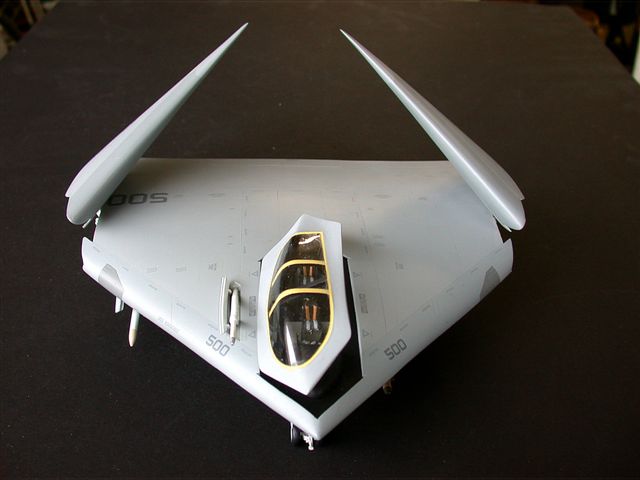 |
|
A-12 Avenger II |

HyperScale is proudly sponsored by Squadron
The distinctively shaped A-12 "Avenger II", popularly known as the "Dorito,"
was the Navy's mid-Nineties stealth answer to the Air Force's F-117.
Planned to replace the entire A-6 fleet, the joint General
Dynamics/McDonnell Douglas venture instead suffered the ignominy in 1991
of being the largest DOD contract ever cancelled.
At a cost of approximately
$100 million per airplane, this was a Very Big Deal...620 to the Navy,
283 to the Marines, and even the Air Force considered a buy of 400! The
financial repercussions have lasted over a decade, as the builders sued
the DOD for axing the program for "convenience of the government", not
because of cost overruns and non-performance, as DOD had claimed. The
courts ruled in favor of GD/McD in 1998, allowing the contractors to
recover almost $ 3.9 billion in engineering/construction cost incurred.
The DOD, naturally, appealed, and the appeal is still under
consideration.
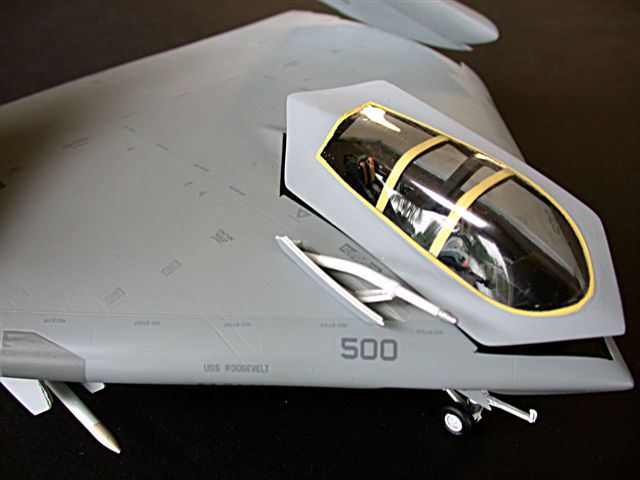
Fortunately the full scale Avenger II mockup was never destroyed by
General Dynamics and has been fully restored by volunteers at Fort
Worth, Texas. Additionally, there is a wealth of reference material,
including detailed structural isometric drawings, on the Internet.
Collect-Aire's
1/48 scale Avenger II
|
Down and Dirty
With the rollout of the
Collect-Aire Avenger II, weary employees of the Weirdness Works Division
of Bondo Industries feel as they've been in a barroom fight. But, all's
well that end's...
The "Patient"
Presents...
The kit's overall molding is very good, with
exceptionally smooth surfaces and petite, crisp engraving that rivals
any of the Big Dogs. But, then there's the problem of fit, which is
always troubling when there are large sections of resin that solidify at
different rates, and the Dorito has such large resin components in
spades!
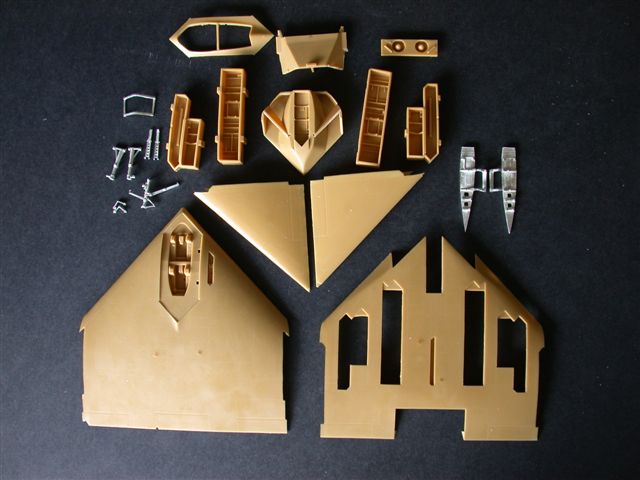
When I read an earlier construction article
on the A-12 which stressed the poor fit of the outer wings to the main
wing/fuselage, I decided to fold the wings, which not only minimizes a
group of modeling sins, but also breaks up the large, monochromatic
surface of a flying wing design. Admittedly, folded wings are offered as
a kit option, but the way-out-of-scale sheetmetal thicknesses, relative
lack of detail and clunky cast metal hinge mechanisms ruled out the use
of stock kit components unless one could stand a distinctly toylike
appearance, and " 'Homey' don't play dat" here at Bondo Industries.
Wingfolds
The stock OOB skin
thickness scaled out to about four inches! Industrial strength
Dremmeling shaved the wingskin surrounding the wingfold bulkheads to
cardstock thickness. Now that the skin was scale, none of the thick,
stock resin bulkheads fit.
Four new bulkheads were
scratchbuilt from plastic sheet and detailed to include hinge locking
mechanisms. The cast metal hinges themselves were modified to fit behind
the new bulkheads.
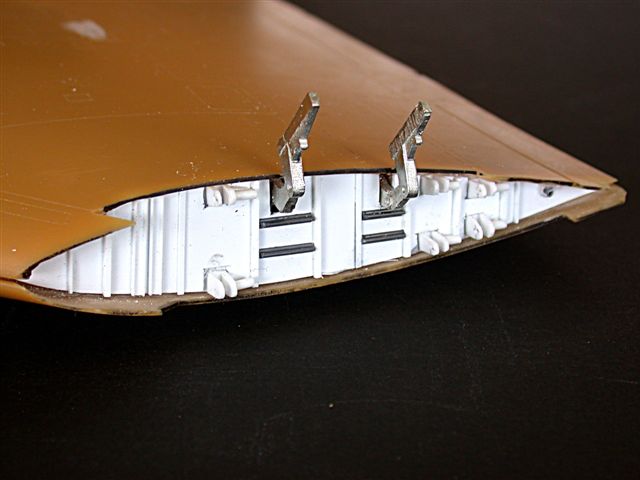
Click on the thumbnails
below to view larger images:
Weapons Bay
It was decided to pose one
weapon bay open on each side of the airframe.The kit's large bays were
painfully plain, so I substituted the old High Flight aftermarket F-117
LGB bay. The nicely detailed bay came with cast metal trapeze arms, a
detailed resin pylon and distinctive GBU-27 "bunker buster." The AAMRAM
bay suffered the same lack of detail, so I adapted the multi-piece
missile erection trapeze from the Monogram F-102 kit.
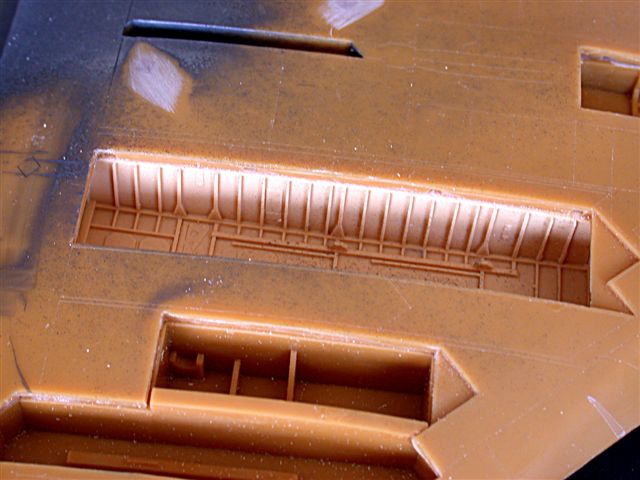
Click on the thumbnails
below to view larger images:
Cockpit/Canopy
Next to the wingfolds, the
large, one-piece canopy was the biggest headache. Instead of simply
creating the canopy and surrounding sheetmetal as one vacuformed piece,
the master modeler unfortunately chose to do a large resin canopy
perimeter, a separately vacuformed canopy and cast metal canopy arches.
Fitting the complex contours of the trimmed canopy to the resin
perimeter was excruciating and required delicate masking and filling of
the mating surface with Blue Acryl. The interior canopy arches were
separated from their clunky joining members and individually trimmed and
fitted to the canopy rails. A scratchbuilt transverse strengthening beam
was also fitted. The funky, hollowed out inside area of the resin canopy
perimeter was filled with A&B epoxy putty, adding much strength to the
whole assembly.
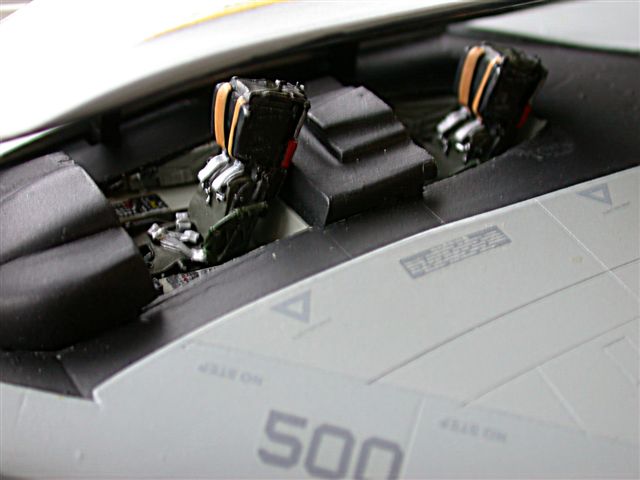
Click on the thumbnails
below to view larger images:
Posing the large canopy
open, as in the case of the wingfolds, clears up fit problems and allows
for detailing of the large cockpit. F-4 resin side panels were adapted
to add to the "busy-ness factor." Also added were resin aftermarket
seats.
As per custom at Bondo Industries, multiple iterations of automotive
lacquer primer, applications of Blue Acryl and wetsanding through 8000
grit preceded multiple color coats of Model Master Acryl Light Ghost
Grey. Next, three coats of Model Master gloss clear paved the way for
decalling.
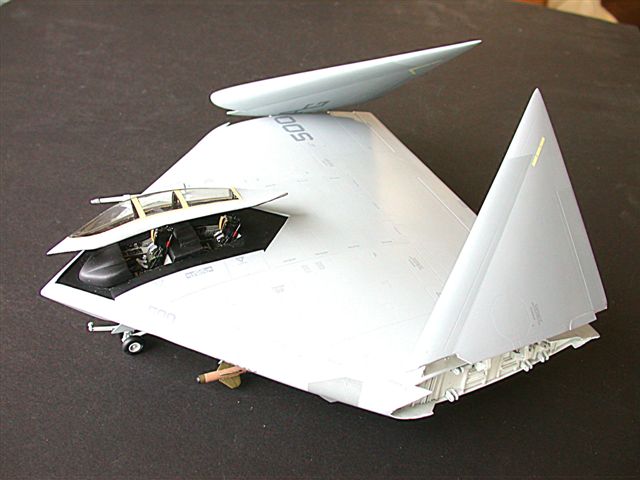
The first nasty surprise
here was when the properly stored Collect-Aire decals (European "MPD"
brand) disintegrated in water. Collect-Aire's Lou Maglio kindly sent two
extra sheets, but these also tended to break up. Applying MicroFilm to
the decal sheet saved the day. Low viz F-18 stencils were added to break
up the airframe's significant top area. Flat Testors Acryl was "dusted"
on which blended in the decals nicely.
Although only the full scale mockup of this innovative-but-expensive
aircraft remains, the program was truly a going deal, not pie-in-the-sky
machinations of aeronautical engineers. This largest of all DOD
cancellations has been fully documented in the book, "The $5 Billion
Misunderstanding; the Collapse of the Navy's A-12 Stealth Bomber
Program" by James P. Stevenson.
Click on the thumbnails
below to view larger images:
Model, Images and Text Copyright ©
2004 by Phil Brandt
Page Created 13 June, 2004
Last Updated
14 April, 2005
Back to
HyperScale Main Page
|
Home
| What's New |
Features |
Gallery |
Reviews |
Reference |
Forum |
Search